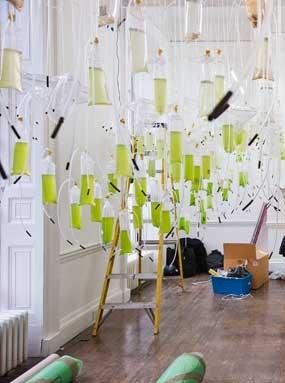January exhibitions at the AA – REVIEW
There are two new exhibitions now showing at the Architectural Association: H.O.R.T.U.S. – an installation by ecoLogicStudio (on the first floor, next door to the café) – and Critical Territories, which presents the work of two experimental interdisciplinary practices, Groundlab and Plasma Studio (in the ground floor gallery space).
H.O.R.T.U.S., which stands for Hydro Organisms Responsive To Urban Stimuli, comprises hundreds of water filled transparent plastic bags, hung from the ceiling to create a wavy carpet form, floating in the space at head height. The bags contain different types of algae, and each one has a tube into which one can blow, providing more CO2 for the organisms to grow. There are also digital displays and ‘interfaces’ positioned around the edge of the room. The intention is to ‘induce multiple mechanisms of self-regulation and evolve novel forms of self-organization’, by ‘triggering’ light radiation (from the windows presumably), biomass (algae), CO2 (breath), and information (internet and user digital input) to create an interactive responsive system. Exactly how this is achieved, however, is rather unclear, as none of the disparate components are really connected up. One is left to conclude that the only means of interconnection is via the processional interaction of the viewer. But then in what way is the meta-mechanism either self-regulating or self-organised. Perhaps this is the point…
Downstairs, in Critical Territories, the walls of the gallery have been transformed into giant lightboxes covered with technical drawings, diagrams, renders, photos and text about selected projects, which focus on the practices’ landscaping and masterplanning work, particularly in China. Various immaculately produced presentation models, as well as less finished conceptual models, are displayed suspended from the ceiling in a grid that divides up the space. These help to explain the technical drawings on the wall but are beautiful in themselves. Of particular interest, is the Longgang project, which attempts to develop an ‘expanded urbanism’ that could cope with the challenges of the contemporary Chinese conditions of city development. This is one of the real theoretical and practical challenges facing architecture today, and it is exciting to see it being tackled by these two practices. In the case of Longgang they attempt to deal with various issues through trying to rethink the possible relationship between the old settlements, the new city development and nature.
Though separate, these two small shows are, then, linked by the theme of the interrelation of nature and the urban environment at a variety of scales. This is an interesting and topical discussion for the field of architecture at this moment. Words: Laurence Lumley © 2011 ArtLyst

